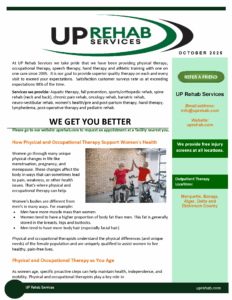Click here to download our full newsletter
How Physical and Occupational Therapy Support Women’s Health
Women go through many unique physical changes in life like menstruation, pregnancy, and menopause. These changes affect the body in ways that can sometimes lead to pain, weakness, or other health issues. That’s where physical and occupational therapy can help.
Women’s bodies are different from men’s in many ways. For example:
- Men have more muscle mass than women.
- Women tend to have a higher proportion of body fat than men. This fat is generally stored in the breasts, hips and buttocks.
- Men tend to have more body hair (especially facial hair)
Physical and occupational therapists understand the physical differences (and unique needs) of the female population and are uniquely qualified to assist women to live healthy, pain-free lives.
Physical and Occupational Therapy as You Age
As women age, specific proactive steps can help maintain health, independence, and mobility. Physical and occupational therapists play a key role in
- Improving bone strength with weight-bearing exercises
- Fall and fracture prevention
- Managing symptoms of menopause, including pelvic floor dysfunction
- Recommending screenings for vitamin deficiencies, such as calcium, vitamin D, and B12
- Providing education on postural health and movement habits
Here are some of the conditions (some of which tend to be more common among women) in which physical and occupational therapy can play an important role:
- Pregnancy-related pain (like low back or heel pain)
- Incontinence or pelvic floor issues
- Osteoporosis or weak bones
- Breast cancer recovery (including swelling and mobility after surgery)
- Joint pain, such as in knees or hips
- Chronic pain, like fibromyalgia
- Balance problems or fall risks as you age
Balance, Strength & Comfort
Every woman is different, and so is every physical and occupational therapy plan. Your therapist will create a plan just for you. It may include:
Muscle retraining – helps develop body awareness and improve daily movement patterns (posture, lifting, sitting). Kegels and Pilates are often used to strengthen pelvic floor muscles.
Exercise Therapy – helps improve mobility, strength, and endurance. This also strengthens bones and joints.
Modalities – application of heat and/or ice, electrical stimulation therapy, and massage therapy to reduce pain, stiffness, and swelling.
Manual therapy – helps improve joint and soft tissue flexibility and mobility by using repetitive and specific hands-on movements and motions.
Whether you’re navigating pregnancy, managing chronic pain, or preparing for healthy aging, physical and occupational therapy can help!
